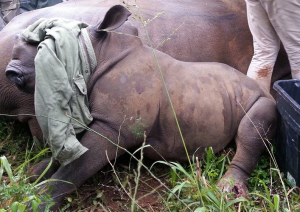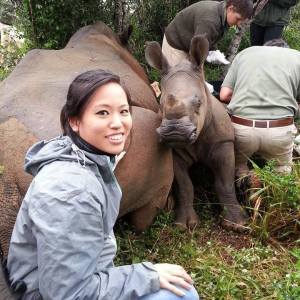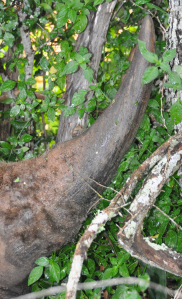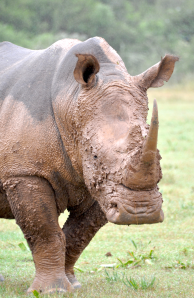Time: 21:15
It’s been an amazing first full day at the reserve.
Woke up at 6.30am and was out of bed with few complaints. This is rare. After breakfast we met our 3 rangers and programme coordinators, and had an introductory talk in the lecture room. Here we learnt about the history of Shamwari, it’s current functions, and more about what we’d be up to as part of the Shamwari Conservation Experience volunteer programme over the next few weeks.
Just as we finished the talk we were informed that a call had come in about an injured rhino,and that if we wanted to be there when it was darted and treated we had better move fast. We moved! We were split up into 3 groups, 1 per vehicle with a ranger in each – 2 female, 1 male. I mention this because it has inspired me to want to train as a game ranger (sometime in the future) even more. Even if it is just to deepen my knowledge of African wildlife and terrain, and give me more practical outdoor skills.
The drive took around 30-45 minutes and conditions were both windy in the open vehicle, and wet from the incessant rain. When we arrived we learnt via radio that the rhino had been darted but had run off and the vet and rangers on duty were attempting to find it. We were instructed to sit tight whilst they located it using the radio tracker. Once they found it, we were on the move again. This time off the beaten paths through acacia bushes that threatened to puncture a few holes in our faces as we drove past. On arrival we discovered both a mother and her baby. It was in fact an injured baby rhino with a big hole in it’s foot that needed to be treated. Of course the mother would have tried to protect it so both had to be darted (tranquillised) for safety reasons. The baby was shaking when we arrived and looked terrified, possibly a result of both the tranquilliser (it may well have been it’s first), and/or the injury. I trust that if it had been our presence we would have been told to stand further away.
Whilst the vets were in action we were allowed to touch the wild mother rhino (tough but surprisingly warm), and also take some photos. The baby looked awake but we were told that it was semi-comatose, so it was ok. I got down to ground level after that to get a closer look at the injury and how it was being treated. It wasn’t pleasant, poor baby, but it was interesting. After watching the foot be bandaged up we moved off again shortly after the ‘wake up’ shots had been administered.
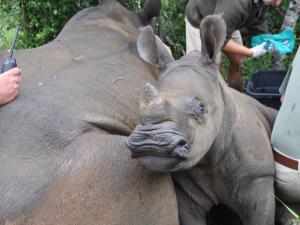
Being treated by vets. Both baby and mother had be darted (tranquillised) in order to safely treat it in the field
The vet then drove down to meet us to explain what he had done, and on being asked what had likely caused the injury he said probably a bull (male rhino). He also said that the bandage was unlikely to stay on in the rainy and muddy conditions so it was not completely out of risk yet. They would keep an eye over the coming days. Medicine was administered as well as something to get rid of the maggots that had infested the wound.
Not a bad way to start the day at all! Definitely one of my favourite experiences to date.
I only hope it does survive.
This is the first time I’ve seen rhino at such close quarters and it really hit home, that this not as large as expected piece of horn (largely consisting of keratin, the same component of our own hair and nails) is the reason for the slaughter of so many of these majestic creatures. To the point of whole species extinction, yet again.
Even though I am a born and bred Londoner I feel some responsibility on behalf of my Malaysian background. Although consumers in Malaysia by no means fuel the majority of the demand for rhino horn (this being China and Vietnam), it still sickens me. The latest statistics from The Department of Environmental Affairs in South Africa reveal that 1,004 rhinos were killed illegally in 2013, the equivalent of nearly 3 animals a day (WWF).
A good article on rhino horn beliefs can be found here:
‘Indeed, it is not clear that rhino horn serves any medicinal purpose whatsoever, but it is a testimony to the power of tradition that millions of people believe that it does. Of course, if people want to believe in prayer, acupuncture or voodoo as a cure for what ails them, there is no reason why they shouldn’t, but if animals are being killed to provide nostrums that have been shown to be useless, then there is a very good reason to curtail the use of rhino horn. There are five species of rhinoceros, and with the exception of one subspecies of the African white rhino, all are in danger of being hunted to extinction for their horns. Rhinos as we know them have been around for millions of years… It is heartbreaking to realise that the world’s rhinos are being eliminated from the face of the earth in the name of medications that probably don’t work.‘
If you want to learn more about rhinos, rhino conservation, and what more can be done here are a few sites to check out:
WWF – I have ‘adopted’ one from here
Save the Rhino
African Wildlife Foundation
International Rhino Foundation
The rest of the day after lunch consisted of cutting down trees and bushes blocking the road using machetes and saws. Something I really suck at, mainly because I was very careful (and therefore slow) knowing how accident-prone I am. As we were driving along the river on the way to our second work site we turned a corner and encountered a big male giraffe coming towards us. We had a mountain to our left and a river bank with hippos somewhere in the water to our right. There was a small gap in which it was possible for him to pass us however this one was somewhat cowardly, dithering for 20 minutes or so about whether to proceed past us or turn back. He must have changed his mind 3 or 4 times. And they say females can’t make their minds up! This one basically made us so late that we didn’t end up working the 2nd site and went straight back for dinner. Not a huge disaster considering the alternative was being stabbed by more thorns.
The plan for tomorrow seems to be putting down boulders and rocks along fences in the morning and big cat monitoring in the afternoon. Cannot wait!
List of all the wildlife seen in my first 24 hours: zebras, giraffes, warthogs, elephants, white rhinos, black rhinos, buffalo, ostrich, springbok, kudu, impala, red hartebeest, waterbuck, blesbok, vervet monkeys, and a couple of birds that I can’t remember the name of. Obviously I’m not a birder.

